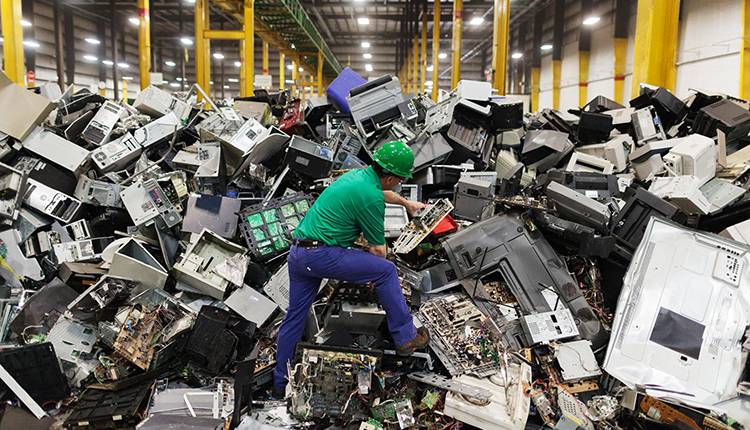Could This Be the Solution to the Global E-waste Problem?
In recent years, the consumer demand for electronics has escalated to a great degree. Consumers today prefer buying a new gadget instead of repairing an old one. This trend has played a major part in the global e-waste crisis.
As per a United Nations Environment Program report, the American electronics industry alone produced about 42 million tonnes of e-waste in 2014!
Why Recycle E-waste
Electronic waste contains many valuable metals. On recycling 1 million cell phones, 35,274 lbs (16,000 kg) copper, 772 lbs (350.1 kg) of silver, 75 lbs (34 kg) of gold and 33 lbs (14.9 kg) of palladium can be recovered. However, according to EPA, only 12.5% of e-waste is recycled. The reason behind such a small fraction being recycled is the presence of toxins and complex compounds.
E-waste from developed nations are exported to developing economies where these precious metals are recovered via hand processing. This method poses a health hazard as it exposes the poor communities to harmful toxins.
The Potential Solution
To combat the global problem of e-waste, a professor from University of New South Wales has found an ingenious method that allows extraction of valuable metals without putting poor communities in danger.
UNSW ARC Laureate, Professor Veena Sahajwalla is the brains behind this breakthrough. She has developed micro-factories that offer a safe and low-cost method for mining electronic waste. These micro-factories can be set-up in containers and transported to waste sites, negating the need to transport e-waste over long distances. As a result, the high transportation costs are avoided.
She says, “The world urgently needs a safe, low cost recycling solution for e-waste. Our approach is to enable every local community to transform their e-waste into valuable metal alloys, instead of leaving old devices in drawers or sheds, or sending them to landfill.”
The Process
Professor Veena Sahajwalla uses programmed drones to identify printed circuit boards from crushed e-waste. To avoid human contact, a simple robot extracts them before they are dropped into the furnace.
Then, the micro-factories use precisely controlled high-temperature reactions to create copper and tin-based alloys from unwanted printed circuit broads. During the process, toxins are destroyed at the same time.
“We already understand the value of sourcing green energy from the sun, similarly we can source valuable green materials from our waste. ‘Mining’ our waste stockpile makes sense for both the economy and the environment,” she adds.
Leave a Reply Cancel reply
Recent Posts
- Understanding The Materials That Are Used To Build Plastic Toys
- All You Need To Know About Food-grade Plastics
- A Glance At The Materials That Boost The Performance Of Plastics
- Understanding The Importance Of Exploring New Business Opportunities In The Plastic Industry
- Understanding The Importance Of Investing in R&D For The Plastic Industry
Categories
- 3D Printing
- AIPMA
- Automation
- Automobile Sector
- Bio Plastics
- Environment
- Innovations In Recycling
- Latest Innovations
- Molds & Dies
- News
- Packaging Industry
- Plastic
- Plastic Application
- Plastic Industry
- Plastic Market
- Plastic Myths
- Plastic News From The World
- Plastic Packaging
- Plastic Products
- Plastic Recycling
- Plastic Solar Cells
- Plastic Toys
- Plastic Waste
- Plastic World
- Plastics
- Plastics And Their Applications
- Plastics In Agriculture
- Plastics In Healthcare
- Plastics In Medical Industry
- Plasticulture
- Processing Machinery
- Recycling Machines
- Robotics
- Uncategorized
- Virtual Reality
Archives
- November 2023 (3)
- October 2023 (2)
- September 2023 (3)
- August 2023 (3)
- July 2023 (3)
- June 2023 (3)
- May 2023 (2)
- April 2023 (2)
- March 2023 (2)
- February 2023 (2)
- January 2023 (2)
- December 2022 (3)
- November 2022 (1)
- October 2022 (1)
- September 2022 (2)
- August 2022 (1)
- July 2022 (3)
- May 2022 (3)
- March 2022 (2)
- February 2022 (1)
- January 2022 (1)
- September 2021 (2)
- August 2021 (3)
- July 2021 (4)
- June 2021 (4)
- May 2021 (3)
- April 2021 (2)
- March 2021 (4)
- November 2019 (8)
- October 2019 (8)
- September 2019 (8)
- August 2019 (8)
- July 2019 (8)
- June 2019 (8)
- May 2019 (8)
- April 2019 (8)
- March 2019 (8)
- February 2019 (11)
- January 2019 (8)
- December 2018 (8)
- November 2018 (12)
- October 2018 (12)

